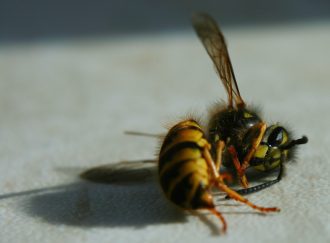Guest writer for Wake Up World
Many plants produce offspring (seeds) via the transfer of pollen from the male of one flower to the female stigma of another. While wind and water can transfer pollen to some extent, and some plants are self-pollinating, animal pollinators are the primary route of pollen transfer for most plants — including those we depend on for food.
The pollination process is quite incredible, really, carried out by certain birds, butterflies, bats, moths and bees (along with some other animals like honey possums.) When the pollinator feeds from a flower, the pollen attaches to its body and then deposits on another flower during the pollinator’s next stop.
When examined more closely, however, there are even more details to this process that make it that much more amazing…
Bees Are Hardwired for ‘Buzz Pollination’
[pro_ad_display_adzone id=”110028″]
Bees use a process called sonication, or buzz pollination, to shake loose pollen hidden in certain plants’ anthers. The bees bite the anthers to hold on, then buzz. The sonic vibration causes the pollen to spill out of the plant and stick to the bee.
Experiments conducted by University of Arizona researchers found that rather than being a learned behavior, bees appear to be hard-wired to use sonication. The study included bees raised in a laboratory that had never seen a flower [1] yet, when they were given the chance, the bees knew just what to do. As The New York Times reported, the bees instinctively:[2]
- Grabbed the plant’s anther with their mandibles
- Buzzed until they were doused in pollen
- Groomed the pollen off their front legs and body and stuck it to “pollen baskets” on their rear legs
Having an innate ability for sonication has its benefits, including making bees highly adaptable to changing environments. If new plants come into a bees’ range, or if they’re forced to forage in unfamiliar areas, it means the bees should still be able to adapt.
Queen Bees Dying From Pesticide Exposure and Parasites
There is only one queen bee per hive. She mates once and then is fertile for life, laying up to 2,000 eggs per day to sustain the colony.
Research published in the journal Nature suggests, however, that combined exposure to neonicotinoid pesticides and parasites may alter queen bees’ physiology and survival, thereby potentially destroying the whole hive.[3] For example, queen bees exposed to infection with the parasite Nosema ceranae along with 0.7 micrograms per liter of a neonicotinoid called imidacloprid — which is a dose a bee may realistically be exposed to in the wild — showed serious adverse effects. More than 90 percent of the exposed queen bees died within 45 to 90 days (a healthy queen bee may live for several years.) The researchers continued:[4]
Furthermore, single and combined effects of pesticide and parasite decrease survivorship of queens introduced into mating hives for three months. Because colony demographic regulation relies on [the] queen’s fertility, the compromise of its physiology and life can seriously menace colony survival under pressure of combined stressors.
Past studies have also found that combined stressors may be leading to bee losses. In 2013, for instance, researchers found that when pollen was fed to healthy bees, they had a significant decline in the ability to resist infection with the Nosema ceranae parasite, which has been implicated in Colony Collapse Disorder (CCD), the term often used to describe bee die-offs.[5]
Each Neonicotoinoid May Harm Bees in Different Ways
Neonicotinoids are powerful neurotoxins and are quite effective at killing pests, but they’re also harmful to non-target pests, namely pollinators such as bees and butterflies.
This occurs because the pesticides are taken up through the plant’s vascular system as it grows and, as a result, the chemical is expressed in the pollen and nectar of the plant.
Until now, the effects of different neonicotinoids have been regarded as interchangeable, but one study showed each may affect bees differently. Bayer’s imidacloprid was found to cut the number of egg-containing brood cells by 46 percent, for instance.
Syngenta’s thiamethoxam, on the other hand, decreased the number of live bees by 38 percent.
Clothianidin, another neonicotinoid made by Bayer, had the curious effect of increasing the number of queens produced, which the researchers noted could potentially backfire if, “say, all those queens turned out to be infertile.”[6],[7]
Lead researcher Christopher Connolly, Ph.D., and reader in neurobiology at the University of Dundee, told The Guardian, “I think there is sufficient evidence for a ban on imidacloprid and thiamethoxam … “[8]
Neonicotinoids Are Harming Wild Bees, Too
Neonicotinoid pesticides, which are widely used in intensive agricultural operations, have been widely implicated in the decline of commercially bred bees, but research published in Nature Communications has now shown these chemicals are leading to long-term population changes in wild bees as well.[9]
The study involved 18 years of U.K. wild bee distribution data for 62 species, which were compared to amounts of neonicotinoid use in oilseed rape, a crop grown to produce canola oil. The researchers found evidence of increased wild bee population extinction rates in response to neonicotinoid seed treatment.
While bees that forage on oilseed rape have historically benefited from its availability, according to the researchers, once the crops are treated with neonicotinoids (as up to 85 percent of England’s oilseed rape crops are) they have detrimental impacts on the bees.
In fact, wild foraging bees were three times more likely to be negatively affected by exposure to neonicotinoids than non-crop foragers. Overall, about 50 percent of the total decline in wild bees was linked to the pesticides.[10]
Mosquito Spraying for Zika Virus Is Exterminating More Bees
Bees are now facing yet another chemical threat, this time in the form of pesticides being sprayed to kill mosquitoes in the name of Zika-virus prevention. In Summerville, South Carolina, millions of bees were killed when a small area of the town was aerially sprayed for mosquitoes.[11]
[pro_ad_display_adzone id=”110030″]
The pesticide sprayed was Naled, a neurotoxin that’s used to target adult mosquitoes. However, it’s also toxic to other insects, birds and fish. The bee losses are that much more tragic because, as of this writing, no cases of locally acquired Zika infection have been reported in South Carolina.
While officials in the area have previously sprayed for mosquitoes from the road, this is the first time aerial spraying has been used. Officials apparently did not consider how the spraying would affect other species, however, including bees, and did not follow standard procedure of notifying registered beekeepers about the spraying.
Beekeeper Juanita Stanley lost all 46 of her hives — amounting to millions of bees — in the apparently accidental extermination. Stanley told The New York Times:[12]
There was no need for a bee suit Monday morning to go … Honestly, I just fell to the ground. I was crying, and I couldn’t quit crying, and I was throwing up … This is going to sound harsh, but I think for me, this one word is very fitting, and it’s ignorance … We, as humans, are not doing the research and finding out the facts before we make decisions.
Bees Obtain Both Food and Bacteria From Flowers
The long-term effects that excessive pesticide usage may have on bees and other pollinators is unknown, particularly since we’re still learning about the intricate connections pollinators have with their environment. In fact, new research published in the journal Microbial Ecology highlighted the fact that wild bees, like humans and commercially bred bees, have a community of microorganisms, including bacteria, known as a microbiome.
The study found that many flowers and wild bee species share certain types of bacteria, which suggests bees obtain not only food but also bacteria from the flowers.[13] In particular, one type of bacteria, Lactobacillus, was found on all the flower and bee samples. The researchers suggested it might help preserve nectar and pollen that the wild bees store in their nest to feed larvae. The study also found flowers that had not yet been visited by bees contained bacteria:[14]
The presence of bee-associated bacteria in flowers that have not been visited by bees suggests that these bacteria may also be transmitted to flowers via plant surfaces, the air, or minute insect vectors such as thrips.
Tell Bayer to Stop Producing Neonicotinoids
It’s extremely important that steps are taken to protect bees, butterflies and other pollinators. These creatures are necessary to help 80 percent of flowering plants reproduce and are involved in the production of 1 out of every 3 bites of food we take. A sampling of the produce that would disappear without bees is listed below. Imagine a world without them! [15]
| Apples | Onions | Broccoli | Lemons | Limes | Cucumbers | Avocados |
| Carrots | Mangos | Leeks | Kale | Bok choy | Broccoli rabe | Eggplant |
| Cantaloupe | Honeydew | Celery | Green onions | Zucchini | Summer squash | Cauliflower |
One way you can take action is by joining Friends of the Earth’s campaign to tell Bayer, the leading manufacturer of neonicotinoids, to stop producing these toxic chemicals. As they stated:[16]
We need bees to pollinate [two-thirds] of the food crops we eat every day — healthy fruits and vegetables matter far more than Bayer’s extra profits! So now we need to show Bayer’s CEO that his toxic chemicals are tarnishing the Bayer brand and harming its business.
Buyer Beware: Your Honey May Be Contaminated With Glyphosate
In related news, the U.S. Food and Drug Administration (FDA) — which has been under pressure to test foods for the presence of glyphosate, a probable human carcinogen — recently revealed it found the toxic weed killer in samples of honey. Showing just how ubiquitous glyphosate has become, the testers were unable to locate a single sample of honey that did not contain it.
For example, Carmichael’s Honey, produced in Louisiana, contained 107 parts per billion (ppb) of glyphosate; Leighton’s Orange Blossom Honey from Florida had 22 ppb and Sue Bee Honey from Iowa contained 41 ppb. According to the Huffington Post:[17]
All of the samples the FDA tested in a recent examination contained glyphosate residues, and some of the honey showed residue levels double the limit allowed in the European Union, according to documents obtained through a Freedom of Information Act request …
Even ‘organic mountain honey’ contained low concentrations of glyphosate, the FDA documents show … In addition to honey, the records show government residue experts discussing glyphosate found in soybean and wheat samples … and the belief that there could be “a lot of violation for glyphosate”residues in U.S. crops.
How to Create a Bee-Friendly Garden
To avoid harming bees and other helpful pollinators that visit your garden, swap out toxic pesticide and lawn chemicals for organic weed and pest control alternatives. Even some organic formulations can be harmful to beneficial insects, so be sure to vet your products carefully.
Better yet, get rid of your lawn altogether and plant an edible organic garden. Both flower and vegetable gardens provide good honeybee habitats. It’s also recommended to keep a small basin of fresh water in your garden or backyard, as bees actually do get thirsty.
In addition, you’ll want to grow your own pollinator-friendly plants from organic, untreated seeds. If you opt to purchase starter plants, make sure to ask whether or not they’ve been pre-treated with pesticides. Keep in mind that you also help protect the welfare of all pollinators every time you shop organic and grass-fed, as you are actually “voting” for less pesticides and herbicides with every organic and pastured food and consumer product you buy.
The video above, from the Pesticide Research Institute (PRI), gives examples of 12 pollinator-friendly plants that are good sources of nectar and pollen to add to your garden.
Article references: see below.
About the author:
 Born and raised in the inner city of Chicago, IL, Dr. Joseph Mercola is an osteopathic physician trained in both traditional and natural medicine. Board-certified in family medicine, Dr. Mercola served as the chairman of the family medicine department at St. Alexius Medical Center for five years, and in 2012 was granted fellowship status by the American College of Nutrition (ACN).
Born and raised in the inner city of Chicago, IL, Dr. Joseph Mercola is an osteopathic physician trained in both traditional and natural medicine. Board-certified in family medicine, Dr. Mercola served as the chairman of the family medicine department at St. Alexius Medical Center for five years, and in 2012 was granted fellowship status by the American College of Nutrition (ACN).
While in practice in the late 80s, Dr. Mercola realized the drugs he was prescribing to chronically ill patients were not working. By the early 90s, he began exploring the world of natural medicine, and soon changed the way he practiced medicine.
In 1997 Dr. Mercola founded www.Mercola.com, which is now routinely among the top 10 health sites on the internet. His passion is to transform the traditional medical paradigm in the United States. “The existing medical establishment is responsible for killing and permanently injuring millions of Americans… You want practical health solutions without the hype, and that’s what I offer.”
Visit Mercola.com for more information, or read Dr. Mercola’s full bio and résumé here.
Recommended articles by Dr. Mercola:
- The Biggest Cause of Anxiety and Depression is Traumatic Life Events
- Zika: Brazil Admits It’s Not the Virus
- Plants Are Smarter Than You Think
- How the War on Drugs Has Caused More Harm Than Good
- The One Size Fits All Vaccination Schedule is Not Safe for Every Child
- Scientific Links Between Processed Foods and Depression
- How Sugar Harms Your Brain Health and Drives Alzheimer’s Epidemic
- The Health Benefits of Intermittent Fasting
- Can a Hug a Day Keep Infection Away?
- Fluoride Deception Continues: US Government Ignores Fluoride’s Role as an Endocrine Disruptor
- Magnesium: An Invisible Deficiency That Could Be Harming Your Health
- Medical Errors: Still the Third Leading Cause of Death
- The Magic Healing Power of Mushrooms
- The Science of Healing Thoughts
Article references:
- [1] Behavioral Ecology December 9, 2015
- [2] The New York Times September 6, 2016
- [3],[4] Nature August 31, 2016
- [5] PLoS ONE 8(7): e70182.
- [6] The Guardian April 28, 2016
- [7] Scientific Reports April 28, 2016
- [8] The Guardian April 28, 2016
- [9] Nature Communications August 16, 2016
- [10] BBC News August 16, 2016
- [11] Nature World News September 6, 2016
- [12] The New York Times September 2, 2016
- [13],[14] Microbial Ecology September 3, 2016
- [15] PR Newswire June 12, 2013
- [16] Friends of the Earth, It’s Bayer vs. the bees
- [17] Huffington Post September 15, 2016
- Behavioral Ecology December 9, 2015
- The New York Times September 6, 2016
- EFE August 31, 2016
- Nature World News September 6, 2016
- The New York Times September 2, 2016
- News Leader September 7, 2016
- Science Daily September 6, 2016
- Microbial Ecology September 3, 2016
[pro_ad_display_adzone id=”110027″]







